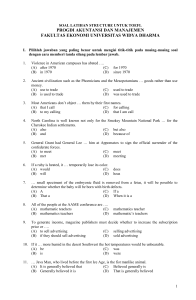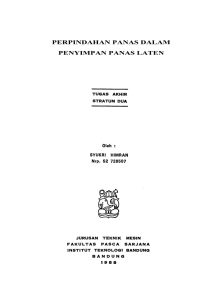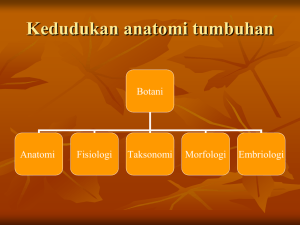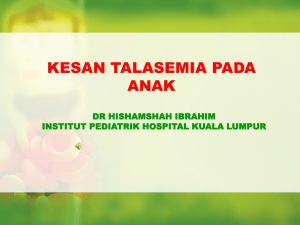Agatha – Nurhening
advertisement
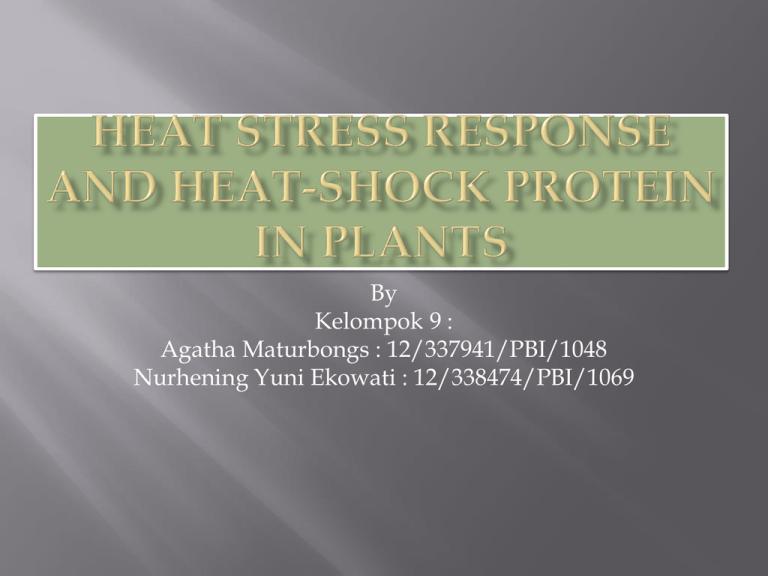
By Kelompok 9 : Agatha Maturbongs : 12/337941/PBI/1048 Nurhening Yuni Ekowati : 12/338474/PBI/1069 Plants as sessile organisms are exposed persistently changing stress factors. Primary stress such as drought, salinity, cold and hot temperatures and chemicals are interconnected in their effect on plants.These factors cause damaged to the plant cell and lead to secondary stresses such as osmotic and oxidative stresses. Plants adapt morphologically and physiologically and biochemically Active plants growth in mesophile organisms is 10-40oC. Any temperature which is under and below that range creates heat stress on metabolic activities of plants. High temperature morpho-anatomical, physiological and biochemical changes in plants Plants growth and development Reduction in economic yield Heat stress response is a reaction when tissues and cells of an organism were exposed to sudden heat stress. HS response is initiated by the activation of heat shock factors (HSF) which cause expression of heat shock gene to synthesis heat shock proteins Heat shock proteins (HSPs) are spesific protein that are made when cells are briefly exposed to temperature above their normal growth temperature. Heat stress respon and HSPs are highly conserved in every organism. HSPs can also be induced other stressor such as oxidants, toxins, heavy metals, free radicals, and viruses, so they are sometimes called the “stress protein” Most heat shock proteins are chaperon, they protecting plants againt stress by reestablishing normal conformation and thus cellular homeostasis. HSF is a regulator in HSPs synthesis. These proteins are grouped in plants into five classes according to their approximate molecular weight : (1) Hsp100 (2) Hsp90 (3) Hsp70 (4) Hsp60 (5) sHsps Arabidopsis, the genetic model for studying and manipulating the heat stress response. Transgenic overexpression of Arabidopsis thaliana heat shock transcription factor (HSF) results in a synthesis of HSPs at normal temperature and significantly increased basal thermotolerance. Plants and animals share similar mechanisms in the heat shock (HS) response, such as synthesis of the conserved HS proteins (Hsps). In general they require unique features to cope with heat stress. Hsa32 is a conserved HS-inducible gene in land plants The gene responds to HS at the transcriptional level in moss (Physcomitrella patens), Arabidopsis (Arabidopsis thaliana), and rice (Oryza sativa). Hsa32 Is a Conserved HSInducible Gene in Land Plants Hsa32 Protein Is Synthesized in Response to HS Charng et al, 2006 Wang et al, 2004 Wang et al, 2004 Al-wahibi, M. H. 2010. Plant heat-shock protein : a mini review. Journal of King Sau University xxx: xxx-xxx Baniwal, S. K, K. Bharti1, K. Y. Chan, M. Fauth, A. Ganguli, S. Kotak, S. K. Mishra, L. Nover, M. Port, K. Scharf, J. Tripp, C. Weber, D. Zielinski and P. V. Koskull-döring. 2004. Heat stress response in plants: a complex game with chaperones and more than twenty heat stress transcription factors. J. Biosci. 29(4) : 471-487 Charng, Yee-yung, Hsiang-chin Liu, Nai-yu Liu, Fu-chiun Hsu, and Swee-suak Ko. 2006. Arabidopsis Hsa32, a Novel Heat Shock Protein, Is Essential for Acquired Thermotolerance during Long Recovery after Acclimation. Plant Physiology, Vol. 140, pp. 1297–1305 Wahid, A., S. Gelani, M. Ashraf, M.R. Foolad. 2007. heat tolerance in plants : an Overview. Environmental and experimental Botany 61 : 199223 Wang, Wangxia, Basia Vinocur, Oded Shoseyov and Arie Altman. 2004. Role of plant heat-shock proteins and molecular chaperones in the abiotic stress response. TRENDS in Plant Science Vol.9 No.5. SEKIAN DAN TERIMA KASIH 1. 2. Bagaimana hubungan antara rusaknya perikarp pada buah tomat? bagaimana kaitannya dengan glisin betain? jawab : kerusakan perikarp pada buah tomat disebabkan oleh adanya cekaman panas yang merusak membran sel. Panas menyebabkan perubahan integritas dan fluiditas membran, serta menyebabkan enzim-enzim yang terdapat di dalam sel terdenaturasi sehingga sel menjadi mati. Selain itu dengan adanya cekaman panas menyebabkan sintesis likopen terganggu dan bahkan tidak terjadi, kemungkinan karena enzim yang terlibat dalam sintesis likopen mengalami denaturasi. sedangkan glisin betain merupakan salah satu protein osmoprotektan , peningkatan konsentrasi glisin betain dalam cekaman panas adalah untuk menjaga homeostasis sel, yaitu dengan menjaga tekanan osmosis di dalam sel. Bagaimana kaitan Hsf yang dioverekspresikan pada tanaman? Jawab : overekspresi Hsf pada tanaman menyebabkan tanaman lebih toleran terhadap cekaman panas. 3. 4. Apakah pada tumbuhan memiliki semua jenis hsp? Jawab: pada 1 jenis tumbuhan tidak memiliki semua jenis hsp, masing-masing tumbuhan memiliki hsp yang berbeda-beda tergantung adaptasi dan stres yang dialaminya. Misalnya Arabidopsis memiliki 18 gen yang mengkode pembentukan Hsp70 dan Hsp90, Hsp100 dimiliki oleh beberapa tanaman antara lain Arabidopsis, kedelai tembakau, padi dan jagung. Hsp di hasilkan di bagian mana saja pada tumbuhan? Jawab : Hsp dihasilkan pada berbagai organel sel, misalnya Hsp70 dihasilkan pada sitosol, kloroplas, dan mitokondria, sedangkan Hsp22 dihasilkan pada retikulum endoplasma.
